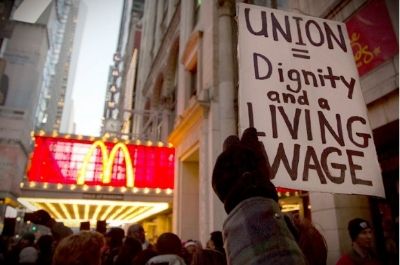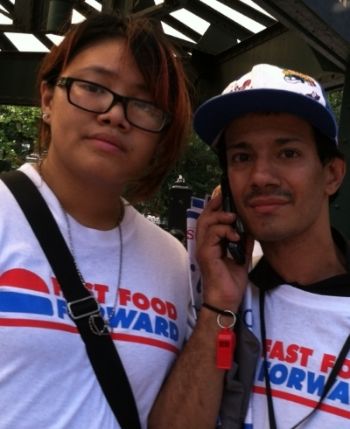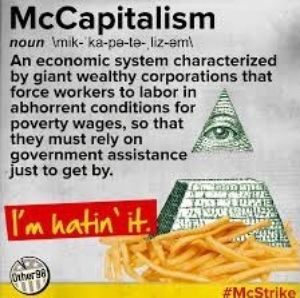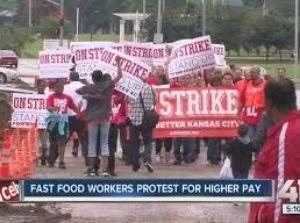(10 am. – promoted by ek hornbeck)
“We are the Workers, the Mighty, Mighty Workers
Everywhere We Go,
The People Want to Know
Who We Are, So We Tell Them….”

As I walked toward the demo of the Fast Food Workers in Union Square, I heard the words and sounds of this song and couldn’t help but grin. We were back! The workers that is – not the “middle class,” not the “deserving poor”, not “the 99%.” As a working class kid from a union factory family, I got it. Not only because you can’t really go around shouting “Middle Class of the World Unite” or “We are the Mighty Mighty Middle Class” – let’s face, it, it just doesn’t resonate – but because the very concept of “worker” which this movement seems to grasp intuitively changes the very nature of the struggle.
“The Middle Class,” “the poor” and even “the 99%” define us in terms of how much wealth we have or do not have, regardless of how we got it, in the upwardly mobile mantra of Capitalism. As workers we are defined, instead, by what we do, how we appropriate the materials and provide the services necessary for the survival and comfort of the human species. And that is a pretty important difference.
Obama’s “middle class” framing of all that is good and important in society (and god know we all want a better lifestyle) is no more than the standard capitalist divide and conquer, the promise of individual upward mobility for the few at the expense of the many. You too can be one of the chosen. And we often buy into it. We want to see ourselves as “better” because we have been able to buy our own home, or send our children to “private” or “charter” schools. And we rationalize that it is because we deserve it – we’re smarter, more industrious, stronger, our skills are more necessary–not due to the whim of the time and place we were born into or that our skills and success are built on the back of the skills and hard work of others.
All of us have known an aunt who raised kids, worked outside the home all her life, carried on intelligent conversations about the world’s problems, worked for the community and has ended up relatively destitute. What is her value? Is she poor because she deserved it? How about many of our young people today who bought the American Dream, worked hard, even went to college if they could afford it and now, through the vagaries of capitalism are jobless or working in low paying jobs that will not allow them to get that middle class dream (unless they can still inherit it from their parents)?

The term “workers” reunites the labor movement by removing the distinction between the mostly white, working middle class (who usually got their middle class lifestyle through union benefits that their grandfathers fought for) and the less affluent workers who are often people of color, single mothers, immigrants, and increasingly young college educated workers who missed out on the brass ring due to the recent failing economy. As one worker put it:
“I don’t care if you’re blue collar, white, collar, pink collar or no collar — all of us have value. Have you ever stopped to think how hard people work? The people who cook for you, the bus driver who drives you to work in the morning? The people who clean your house and your clothes? Have you ever stopped to say ‘thank you’? If you don’t know how to do that job, or if you don’t want to do that job, the best way to say thank you, no matter how much you make, is to stand in solidarity with us and RAISE THE MINIMUM wage!”
What is just as important is that the concept of “workers” raises the well kept secret that we, the workers, have really got the power in our economic system. If we remove our labor power as a group (strike) the system falls apart and all the money in the world won’t fix it if there are no workers to provide the goods and services we require.
It is true that the transition from a traditional manufacturing economy to a global economy, in which the financial sector has grown exponentially, has given Wall Street a stranglehold on our lives and institutions – from the goods we buy, to our healthcare system, to the jobs available to us, to our congressional representatives and government leaders. And it is a fact that great advances in technology allow capitalists to eliminate jobs or outsource jobs to other countries with increasing mobility.
But one other fact remains. Capitalists still need workers to produce the goods and services that make their profit – billions of us – from the sweatshops of China and the mines in Africa, to the IT techs in Mumbai, to the biologists and chemists working in the rainforests of Brazil, to the oil rig workers in the oil fields of Dubai.
Organizing the Retail Sector
Last month, fast-food workers went on strike in more than 50 cities in the United States, from East to West and North to South. Employees walked out of about 1,000 restaurants. The strikes began in New York in November when workers at several fast food chains, including McDonald’s, Burger King and Wendy’s walked out. The movement still remains pretty small-scale. Prior to Thursday, the largest walkout was this summer when “about 2,200 of the nation’s millions of fast-food workers staged a one-day strike in seven cities.”
What started the movement?
The active online presence of the Fast Food Workers echoes the Occupy Wall Street model – a movement that several supporters of the protests cited as an inspiration. In recent years, in an environment of mobile global capital, there have been efforts to gain worker rights by appealing to the broad solidarity of all workers in society in order to try and change workers’ conditions by changing the laws in society as a whole (“Increase the Minimum Wage” campaign) as well as using consumer/worker boycotts instead of focusing on organizing workers in individual shops.
But sometimes, the catalyst that starts a movement is simply that the capitalists push the boundaries too far in their drive for profit and workers rebel out of necessity. As one Los Angeles striker said, “people can’t survive on the minimum wage.” That much seems pretty clear. Many fast food workers earn the $7.25-an-hour federal minimum wage. Eighty-four percent of the fast food workers in New York City do not even bring home the insufficient legal wages they are entitled to.
If the minimum wage simply kept up with inflation, it would be $10.74 an hour today, but workers insist that is still not enough. Compared to the overall economy, fast-food jobs are twice as likely as other jobs to pay so little that workers are pushed onto public assistance while working full-time. Fast-food jobs pay so little that 52 percent of the families of front-line fast food workers need to rely on public assistance programs (which their employers encourage, instead of picking up the tab), costing taxpayers nearly $7 billion a year. It also says there is not a single state in the country today in which a full-time, minimum-wage worker can afford a two-bedroom apartment. A quarter of fast-food workers have to support families on these wages.
In the past, low paid retail jobs have not been viewed as a good sector to organize workers. The old left has traditionally considered the retail sector less critical to union power than those workers who are in the industrial sector. Steel, oil and manufacturing jobs are viewed as more critical to the development of the means of production and thus a more important point of class struggle. However, much of the manufacturing base in the United States has been outsourced around the world in search of cheap labor, and unions have started organizing the secondary and tertiary job sectors such as public service jobs and the retail industry out of necessity. Nevertheless, even as late as last year, no major unions were supporting or actively seeking to organize fast food workers.
The Fast Food Workers seem to have adopted a broad approach of sporadic one day strikes, attempting to develop a general campaign where workers also rely on the workers as consumers to boycott the stores and as citizens to gain worker rights by changing the laws We have seen some a similar concerted effort by the more progressive labor movement to stop the spread of Walmart stores using similar tactics of one day strikes, consumer boycotts and efforts to use legal structures to keep megastores that use cheap labor out of local areas.
However, according to an article from August 29th in The Atlantic:
“the strikes would have a much better shot at inspiring a change in franchise- and corporate-level policy if fast-food chains perceived one of two threats: (a) a threat to the steady supply of food-service workers who want to be employed at any wage and (b) a threat from consumers demanding higher wages for their fast-food clerks by not buying burgers and fries at McDonald’s.”
Instead, according to the Atlantic, the big-picture doesn’t reveal either of these pressure points.
Changing the Labor Culture
Only six percent of the labor force is currently organized due to increasing capital mobility and technological change. The exploding cost and global spread of mass communications has greatly increased the influence of the moneyed elites at the expense of regular workers. Forty years of Republicans promoting Ayn Rand individualism and historic US racism (the Southern strategy), brought to us courtesy of the money of the wealthy Koch Brothers and their ilk and justified by the recently bought and paid for Supreme Court decision on Citizens United (which just declared that corporations – a financial structure – are “people”) has decimated whatever worker consciousness did exist. The unlimited money poured into advertising and the political campaign process has reached a level where the sheer quantity of money has caused a qualitative change resulting in a level of corruption and control by money over the public sphere that has not been seen previously.
That there is anything left of workers’ consciousness as workers is astounding. To the extent there is a resurgence in workers’ consciousness it is, at least partially due to changes in objective conditions. As the American middle class government employees, teachers and well-paid unionized workers have begun to lose their own benefits due to globalization (so much for American Exceptionalism) and are now crying for support from the rest of the working class, they are finding that, if they want the support of others, they will have to learn to give it back to the low paid workers that they have been ignoring. Fast-food wage activists are now receiving financial and technical support from the Service Employees International Union (SEIU), to the credit of that union. If there is any chance of reuniting the working class, which is necessary if we want to be able to challenge capitalist hegemony, we will finally have to address some long standing inequities in our society.
The Three Headed Hydra of Patriarchy, White Supremacy and Class
This means actually addressing the intertwined issues of sexism, class and racism that have plagued the left and the union movements since their inception. Take the almost universal perception that most fast food and other low paid service workers are low-skilled, unintelligent and inherently undeserving of higher wages. Many of the articles and, in fact, a rational used by a McDonald’s executive himself was that the minimum wage jobs are only for “kids” who later can go to college and get other jobs or work their way up the corporate ladder at McDonald’s.

The real issue here is that most of the jobs are filled by women and people of color. Historically, women have provided most of the labor in the home for free which now forms the fast food service sector. This leads to the perception that women’s labor in general, and particularly household labor such as cooking and cleaning, because you can get it for free, has no value. In fact, “kids” can do it. The same goes for African Americans with the history of slavery. This results in a tautology: that anything that doesn’t cost money has no value and if it has no value it deserves to be underpaid (if paid at all).
In fact, most of the workers are adults between the ages of 20 and 55, one third have families to support, and for most it is their only income, even if they are working part-time (which is another way for McDonald’s to avoid paying benefits). And, by the way, one third have college degrees.
Of course many of the semi-skilled jobs that formed the base of the industrial working class which became the good paying union jobs that allowed the middle class to flourish were also low paid jobs before they were unionized by the CIO in the 1930s. By the way, you should see the list of skills necessary to be a fast and efficient barista (Starbuck’s has them listed in a Taylor like chart). If you’ve ever broken your wrist you need not apply because you probably can’t rotate your hand sufficiently to make the espresso. And this does not begin to describe the flexibility and intelligence it takes to multitask several customers at once, or provide the customer with empathetic nurturing service (This is perhaps the most undervalued of the skills because it is so hard to quantify. I don’t know how many times we will have to listen to the binary intelligence of a computer asking us to press option 22 on the telephone or a touch screen, before we get it).
The McDonald’s Paradox

There is still another good reason to look to Fast Food workers as important to the union movement at this particular juncture of history.
Globalization not only changed the strategies for union organizing, but the strategies for companies themselves. The fast food industry has only developed in the last 40 years with globalization and, unlike your local hot dog stand or diner, it has given birth to some of the largest global multinational monopolies in the world. The McDonald’s Corporation is the world’s largest chain of hamburger fast food restaurants, with 34,000+ locations and 1,800,000 employees, serving around 68 million customers daily in 119 countries, with total assets of over 37 billion and profits of over $6 billion in 2013.
The McDonald’s Corporation’s business model is vertically integrated, meaning it either owns or controls over 80% of the meat industry and has de facto control over most of the products in its food chain from producers of beef, chicken and potatoes, to middle level beef processing plants and warehouses. While the majority of the 34,000 individual outlets are “independent” franchises, McDonald’s owns the land and rents to them and controls their food ordering through a third party. In other countries, McDonald’s restaurants are operated by joint ventures of McDonald’s Corporation and other, local entities or governments.
As a matter of policy, McDonald’s does not make direct sales of food or materials to franchisees, instead organizing the supply of food and materials to restaurants through approved third party logistics operators. (Could this be to avoid Monopoly lawsuits?).
While this “mega” monopoly is very efficient at keeping out competition, it also creates a vulnerability. Since all of its resources are funneled through the individual McDonald’s retail stores, an attack on the individual stores has the possibility of bringing down the whole McDonald’s structure. If workers in even ¼ of their outlets successfully disrupt the corporations business through rolling one day walk-offs in different places around the world, it could back up their entire production chain. Moreover, just as McDonald’s was able to capitalize on the increasingly globalized market and communications, so too can McDonald’s workers get on the internet and talk to other McDonald’s organizers around the globe. We are not suggesting this will happen tomorrow. But however, brief, the degree to which the Fast Food workers were able organize a national campaign in less than a year, suggests that this is a new ball game with new organizing rules.
It’s time for all of us as workers (probably close to 99%) to support each other as a group and to understand the basis of that support. This speaker at a recent Fast Food demo said it best:
Appendix
All week, while writing this article I found myself singing another old song
which pretty well sums up my hopes and fears about the Fast Food Workers
movement. Perhaps you know it:
Once there was a little old ant,
Tried to move a rubber tree plant,
Anyone knows an ant can’t
Move a rubber tree plant….
Oops, there goes another rubber tree plant!
(In solidarity with all the worker ants)
References and further reading:
http://www.democracynow.org/20…
http://www.democracynow.org/20…
Jerry Lanson, Fast-Food Strikes Lend Much-Needed Fire to Largely Dormant Labor Movement
Why the Fast Food Workers Strikes are doomed
Raise the Minimum Wage Campaign
(NYSE: MCD), ( USA Today ) business model, ,(The Atlantic)
Tom Watson http://www.forbes.com/sites/to…


